Strategic Demand Response for Economic Dispatch in Wind-Integrated Multi-Area Energy Systems
Abstract
:1. Introduction
- (1)
- A collaborative optimization framework for MAIESs that integrates wind energy and DR to enhance operational efficiency and system economic efficiency is developed.
- (2)
- Comprehensive analysis of the impact of DR on system sustainability, offering insights into the synergistic effects of DR with other flexibility resources in a multi-area context.
- (3)
- Advanced two-level optimization strategies that address uncertainties in renewable energy generation and dynamic demand patterns are implemented.
2. System Modeling
2.1. Energy Trading with Main Grid
2.2. Wind Farm Power Transactions
2.3. Energy Storage Modeling
2.4. Demand Response Program
2.4.1. Price-Based Demand Response
2.4.2. Replaceable Demand Response
2.5. Power Balance Modeling
- (1)
- Electric power balance
- (2)
- Heat power balance
- (3)
- Cooling power balance
2.6. Objective Function
3. Numerical Analysis
3.1. Data Input
3.2. Results Analysis
4. Conclusions
Author Contributions
Funding
Data Availability Statement
Conflicts of Interest
References
- Liu, L.; He, G.; Wu, M.; Liu, G.; Zhang, H.; Chen, Y.; Shen, J.; Li, S. Climate change impacts on planned supply–demand match in global wind and solar energy systems. Nat. Energy 2023, 8, 870–880. [Google Scholar]
- Hassan, Q.; Viktor, P.; Al-Musawi, T.J.; Ali, B.M.; Algburi, S.; Alzoubi, H.M.; Al-Jiboory, A.K.; Sameen, A.Z.; Salman, H.M.; Jaszczur, M. The renewable energy role in the global energy Transformations. Renew. Energy Focus 2024, 48, 100545. [Google Scholar]
- Liu, T.; Tian, J.; Zhu, H.; Goh, H.H.; Liu, H.; Wu, T.; Zhang, D. Key technologies and developments of multi-energy system: Three-layer framework, modelling and optimisation. Energy 2023, 277, 127697. [Google Scholar]
- Wang, J.; Xu, X.; Wu, L.; Huang, Q.; Chen, Z.; Hu, W. Risk-averse based optimal operational strategy of grid-connected photovoltaic/wind/battery/diesel hybrid energy system in the electricity/hydrogen markets. Int. J. Hydrogen Energy 2023, 48, 4631–4648. [Google Scholar]
- Al Khaffaf, I.; Tamimi, A.; Ahmed, V. Pathways to Carbon Neutrality: A Review of Strategies and Technologies Across Sectors. Energies 2024, 17, 6129. [Google Scholar] [CrossRef]
- Yin, L.; Zheng, D. Hybrid modeling with data enhanced driven learning algorithm for smart generation control in multi-area integrated energy systems with high proportion renewable energy. Expert Syst. Appl. 2025, 261, 125530. [Google Scholar]
- Hu, Z.; Zhang, K.; Su, R.; Wang, R.; Li, Y. Robust Cooperative Load Frequency Control for Enhancing Wind Energy Integration in Multi-Area Power Systems. IEEE Trans. Autom. Sci. Eng. 2024, 22, 1508–1518. [Google Scholar]
- Xi, L.; Shi, Y.; Quan, Y.; Liu, Z. Research on the multi-area cooperative control method for novel power systems. Energy 2024, 313, 133912. [Google Scholar]
- Wu, D.; Guo, F.; Yao, Z.; Zhu, D.; Zhang, Z.; Li, L.; Du, X.; Zhang, J. Enhancing Reliability and Performance of Load Frequency Control in Aging Multi-Area Power Systems under Cyber-Attacks. Appl. Sci. 2024, 14, 8631. [Google Scholar] [CrossRef]
- Lv, C.; Liang, R.; Jin, W.; Chai, Y.; Yang, T. Multi-stage resilience scheduling of electricity-gas integrated energy system with multi-level decentralized reserve. Appl. Energy 2022, 317, 119165. [Google Scholar]
- Wang, J.; Zhao, Y.; Li, H.; Xu, X. Enhanced photovoltaic-powered distribution network resilience aided by electric vehicle emergency response with willingness and reward. Appl. Energy 2025, 389, 125619. [Google Scholar]
- Navesi, R.B.; Naghibi, A.F.; Zafarani, H.; Tahami, H.; Pirouzi, S. Reliable operation of reconfigurable smart distribution network with real-time pricing-based demand response. Electr. Power Syst. Res. 2025, 241, 111341. [Google Scholar]
- Li, Y.; Ma, W.; Li, Y.; Li, S.; Chen, Z.; Shahidehpour, M. Enhancing cyber-resilience in integrated energy system scheduling with demand response using deep reinforcement learning. Appl. Energy 2025, 379, 124831. [Google Scholar]
- Wang, J.; Huang, Q. Minimization of network losses with financial incentives in voluntary demand response. IEEE Access 2018, 6, 16515–16522. [Google Scholar]
- Urrutia, L.Z.; Pascual, J.F.; Iribarren, E.P.; Garay, R.S.; Pino, I.G. Model predictive control with self-learning capability for automated demand response in buildings. Appl. Therm. Eng. 2025, 258, 124558. [Google Scholar]
- Wang, J.; Raza, A.; Hong, T.; Sullberg, A.C.; De Leon, F.; Huang, Q. Analysis of energy savings of CVR including refrigeration loads in distribution systems. IEEE Trans. Power Deliv. 2017, 33, 158–168. [Google Scholar]
- Yang, M.; Liu, Y. Research on multi-energy collaborative operation optimization of integrated energy system considering carbon trading and demand response. Energy 2023, 283, 129117. [Google Scholar]
- De Vizia, C.; Patti, E.; Macii, E.; Bottaccioli, L. A user-centric view of a demand side management program: From surveys to simulation and analysis. IEEE Syst. J. 2022, 16, 1885–1896. [Google Scholar]
- Stennikov, V.; Barakhtenko, E.; Mayorov, G.; Sokolov, D.; Zhou, B. Coordinated management of centralized and distributed generation in an integrated energy system using a multi-agent approach. Appl. Energy 2022, 309, 118487. [Google Scholar]
- Wu, J.; Zhang, Y.; Khan, A. Synergistic nexus among energy security, energy equity and net electricity regions: Optimizing renewable energy integration and demand response for electrical supply systems. Energy Strategy Rev. 2025, 57, 101611. [Google Scholar]
- Wu, G.; Xiang, Y.; Liu, J.; Gou, J.; Shen, X.; Huang, Y.; Jawad, S. Decentralized day-ahead scheduling of multi-area integrated electricity and natural gas systems considering reserve optimization. Energy 2020, 198, 117271. [Google Scholar] [CrossRef]
- Gan, W.; Yan, M.; Yao, W.; Guo, J.; Ai, X.; Fang, J.; Wen, J. Decentralized computation method for robust operation of multi-area joint regional-district integrated energy systems with uncertain wind power. Appl. Energy 2021, 298, 117280. [Google Scholar] [CrossRef]
- He, L.; Lu, Z.; Zhang, J.; Geng, L.; Cai, Y.; Li, X. Economic dispatch of multi-area integrated electricity and natural gas systems considering emission and hourly spinning reserve constraints. Int. J. Electr. Power Energy Syst. 2021, 132, 107177. [Google Scholar] [CrossRef]
- Ahmed, I.; Rehan, M.; Basit, A.; Malik, S.H.; Alvi, U.-E.H.; Hong, K.-S. Multi-area economic emission dispatch for large-scale multi-fueled power plants contemplating inter-connected grid tie-lines power flow limitations. Energy 2022, 261, 125178. [Google Scholar] [CrossRef]
- Kunya, A.B.; Abubakar, A.S.; Yusuf, S.S. Review of economic dispatch in multi-area power system: State-of-the-art and future prospective. Electr. Power Syst. Res. 2023, 217, 109089. [Google Scholar] [CrossRef]
- Chen, X.; Tang, G. Solving static and dynamic multi-area economic dispatch problems using an improved competitive swarm optimization algorithm. Energy 2022, 238, 122035. [Google Scholar] [CrossRef]
- Zhang, S.; Ocłoń, P.; Klemeš, J.J.; Michorczyk, P.; Pielichowska, K.; Pielichowski, K. Renewable energy systems for building heating, cooling and electricity production with thermal energy storage. Renew. Sustain. Energy Rev. 2022, 165, 112560. [Google Scholar] [CrossRef]
- Sharifian, Y.; Abdi, H. Multi-area economic dispatch problem: Methods, uncertainties, and future directions. Renew. Sustain. Energy Rev. 2024, 191, 114093. [Google Scholar] [CrossRef]
- Xie, T.; Ma, K.; Zhang, G.; Zhang, K.; Li, H. Optimal scheduling of multi-regional energy system considering demand response union and shared energy storage. Energy Strategy Rev. 2024, 53, 101413. [Google Scholar] [CrossRef]
- Wang, Y.; Dong, P.; Xu, M.; Li, Y.; Zhou, D.; Liu, X. Research on collaborative operation optimization of multi-energy stations in regional integrated energy system considering joint demand response. Int. J. Electr. Power Energy Syst. 2024, 155, 109507. [Google Scholar] [CrossRef]
- Hua, H.; Du, C.; Chen, X.; Kong, H.; Li, K.; Liu, Z.; Naidoo, P.; Lv, M.; Hu, N.; Fu, M.; et al. Optimal dispatch of multiple interconnected-integrated energy systems considering multi-energy interaction and aggregated demand response for multiple stakeholders. Appl. Energy 2024, 376, 124256. [Google Scholar]
- Jiao, M.; Li, P.; Yang, M.; Wang, Q.; Han, L. Coordinated Flexibility Provision Strategy for Multi-Area Interconnected IEHS. IEEE Trans. Ind. Appl. 2024, 61, 1675–1682. [Google Scholar]
- Guo, Z.; Zhang, R.; Wang, L.; Zeng, S.; Li, Y. Optimal operation of regional integrated energy system considering demand response. Appl. Therm. Eng. 2021, 191, 116860. [Google Scholar]
- Bai, X.; Liu, L.; Ju, J.; Zhong, X.; Zhou, Y.; Lin, J.; Huang, Y.; Wu, N.; Xie, S.; Zhao, Y. Distributed optimization method for multi-area integrated energy systems considering demand response. Front. Energy Res. 2022, 10, 975214. [Google Scholar]
- Ding, L.; Cui, Y.; Yan, G.; Huang, Y.; Fan, Z. Distributed energy management of multi-area integrated energy system based on multi-agent deep reinforcement learning. Int. J. Electr. Power Energy Syst. 2024, 157, 109867. [Google Scholar]
- Mokarram, M.J.; Gitizadeh, M.; Niknam, T.; Okedu, K.E. A decentralized granular-based method to analyze multi-area energy management systems including DGs, batteries and electric vehicle parking lots. J. Energy Storage 2021, 42, 103128. [Google Scholar] [CrossRef]
- Wang, J.; Huang, Q.; Hu, W.; Li, J.; Zhang, Z.; Cai, D.; Zhang, X.; Liu, N. Ensuring profitability of retailers via Shapley Value based demand response. Int. J. Electr. Power Energy Syst. 2019, 108, 72–85. [Google Scholar]
- Yang, P.; Jiang, H.; Liu, C.; Kang, L.; Wang, C. Coordinated optimization scheduling operation of integrated energy system considering demand response and carbon trading mechanism. Int. J. Electr. Power Energy Syst. 2023, 147, 108902. [Google Scholar] [CrossRef]
- Walker, A.; Kwon, S. Analysis on impact of shared energy storage in residential community: Individual versus shared energy storage. Appl. Energy 2021, 282, 116172. [Google Scholar]
- Wang, Y.; Xiong, G.; Xu, S.; Suganthan, P.N. Large-scale power system multi-area economic dispatch considering valve point effects with comprehensive learning differential evolution. Swarm Evol. Comput. 2024, 89, 101620. [Google Scholar]
- Pandey, V.C.; Rawat, T.; Ospina, J.; Dvorkin, Y.; Konstantinou, C. A tri-level distribution locational marginal price-based demand response framework. Electr. Power Syst. Res. 2025, 241, 111398. [Google Scholar]
- Zhang, J.; Zhang, T.; Pan, F.; Yang, Y.; Feng, L.; Huang, Y. Optimization scheduling method for multi-energy complementary based on green certificate-carbon trading mechanism and comprehensive demand response. Energy Rep. 2025, 13, 40–58. [Google Scholar] [CrossRef]
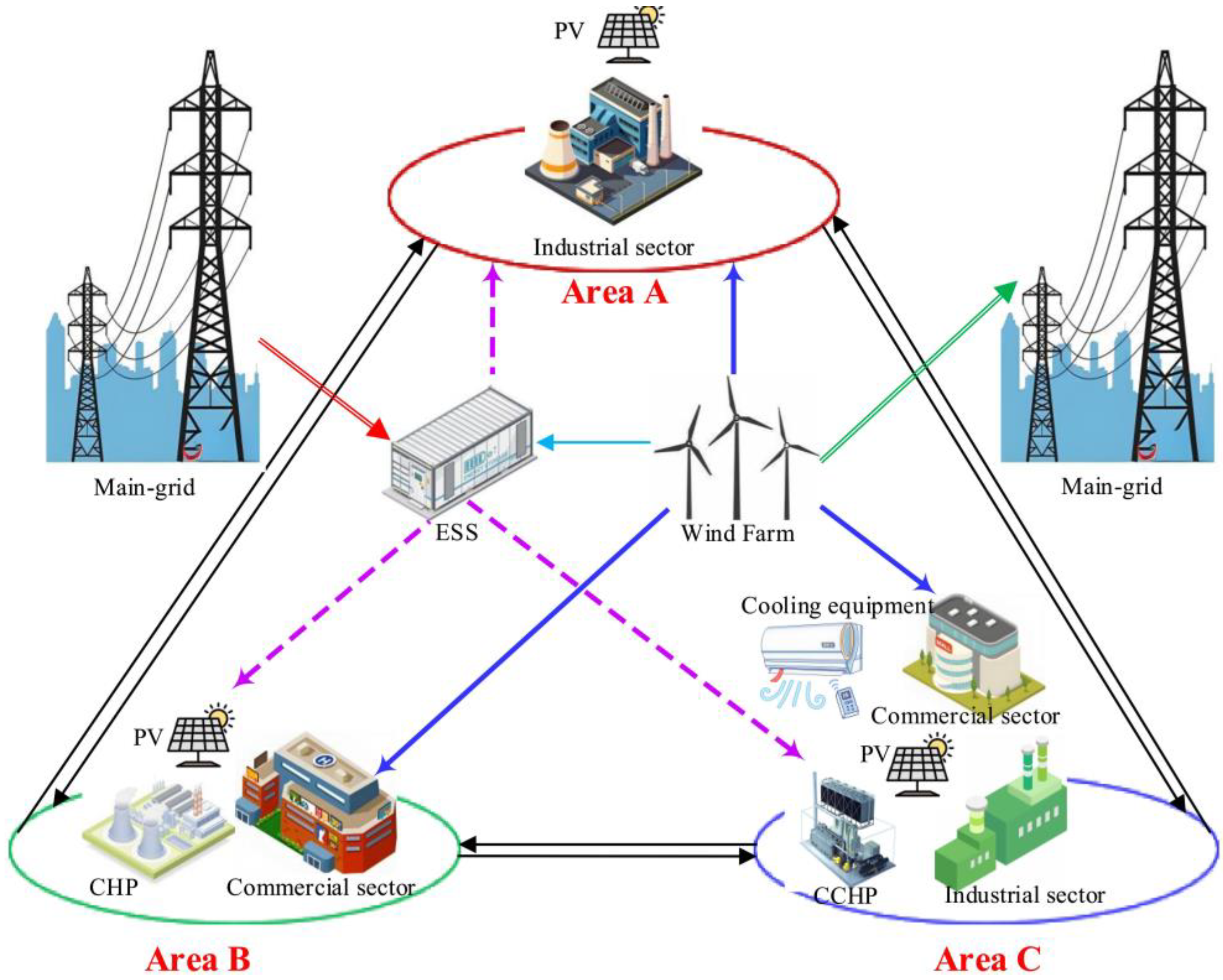
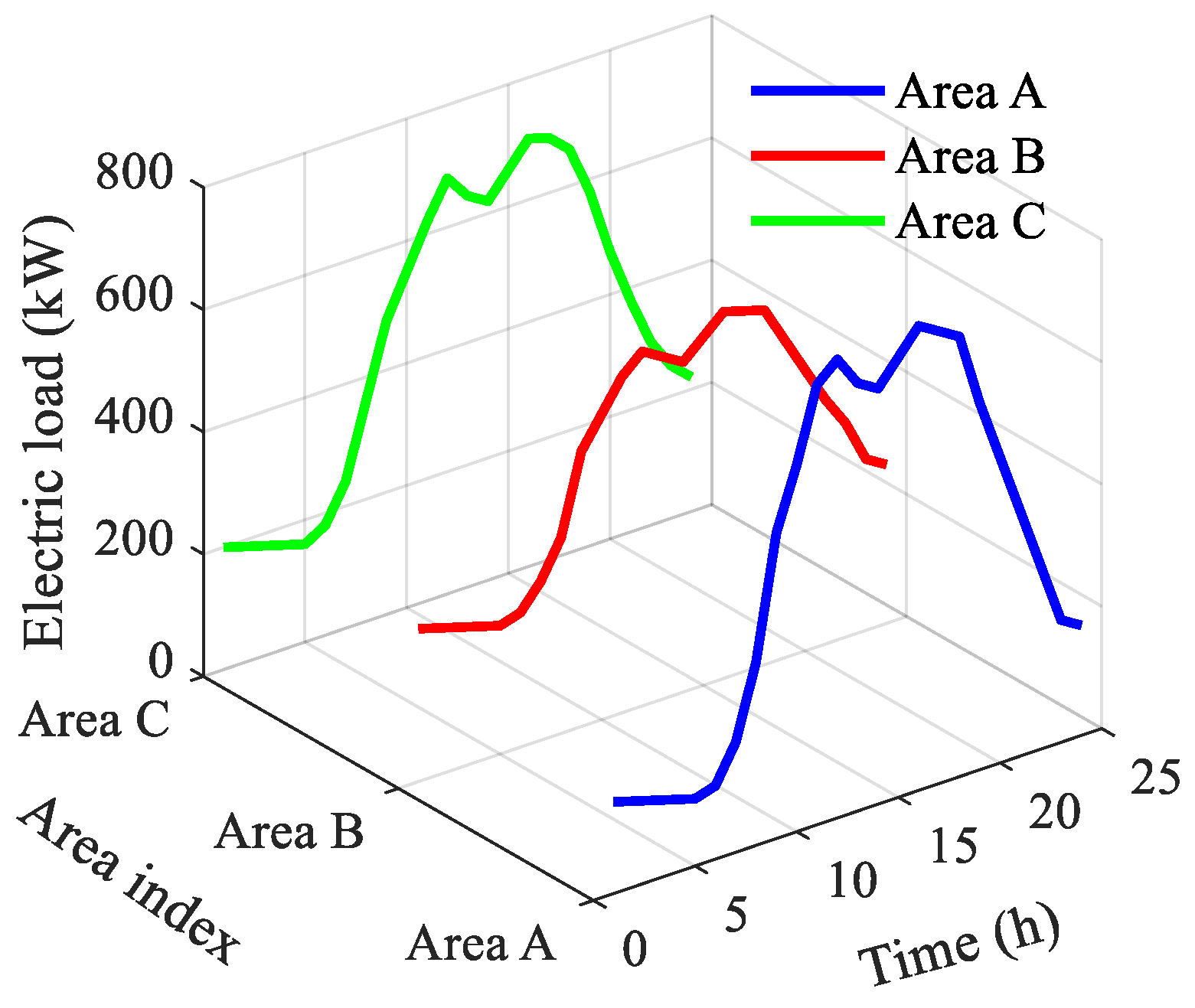
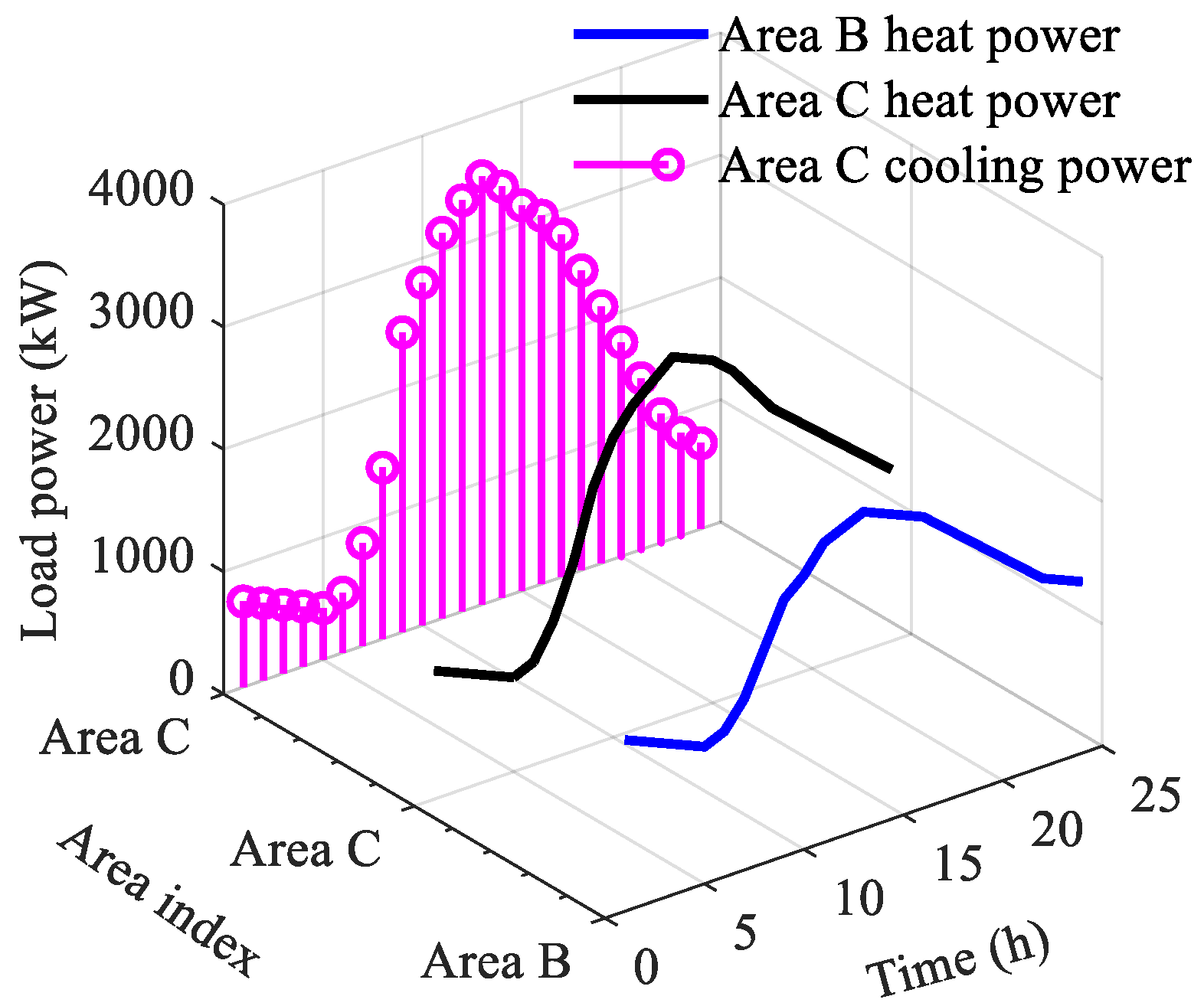

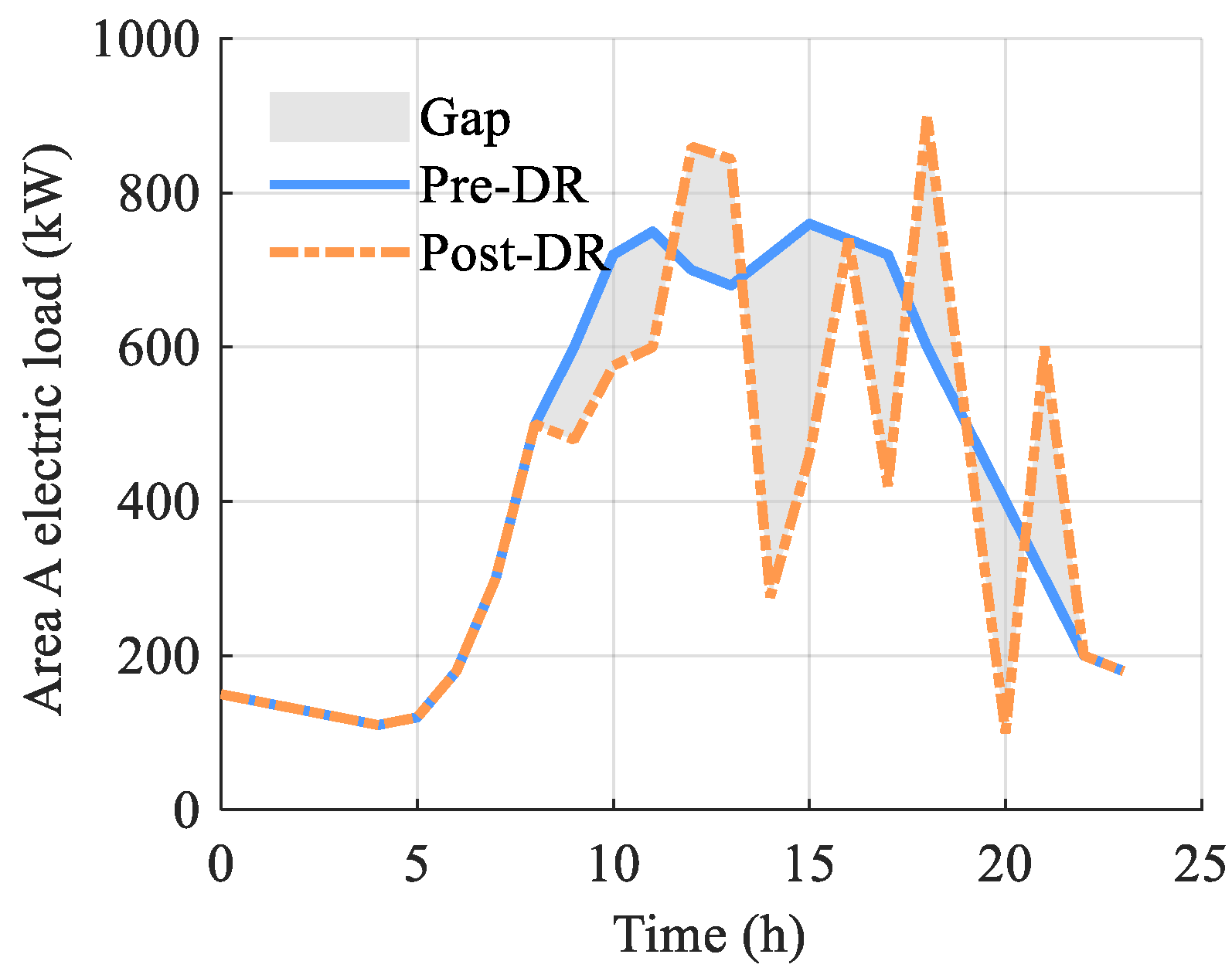

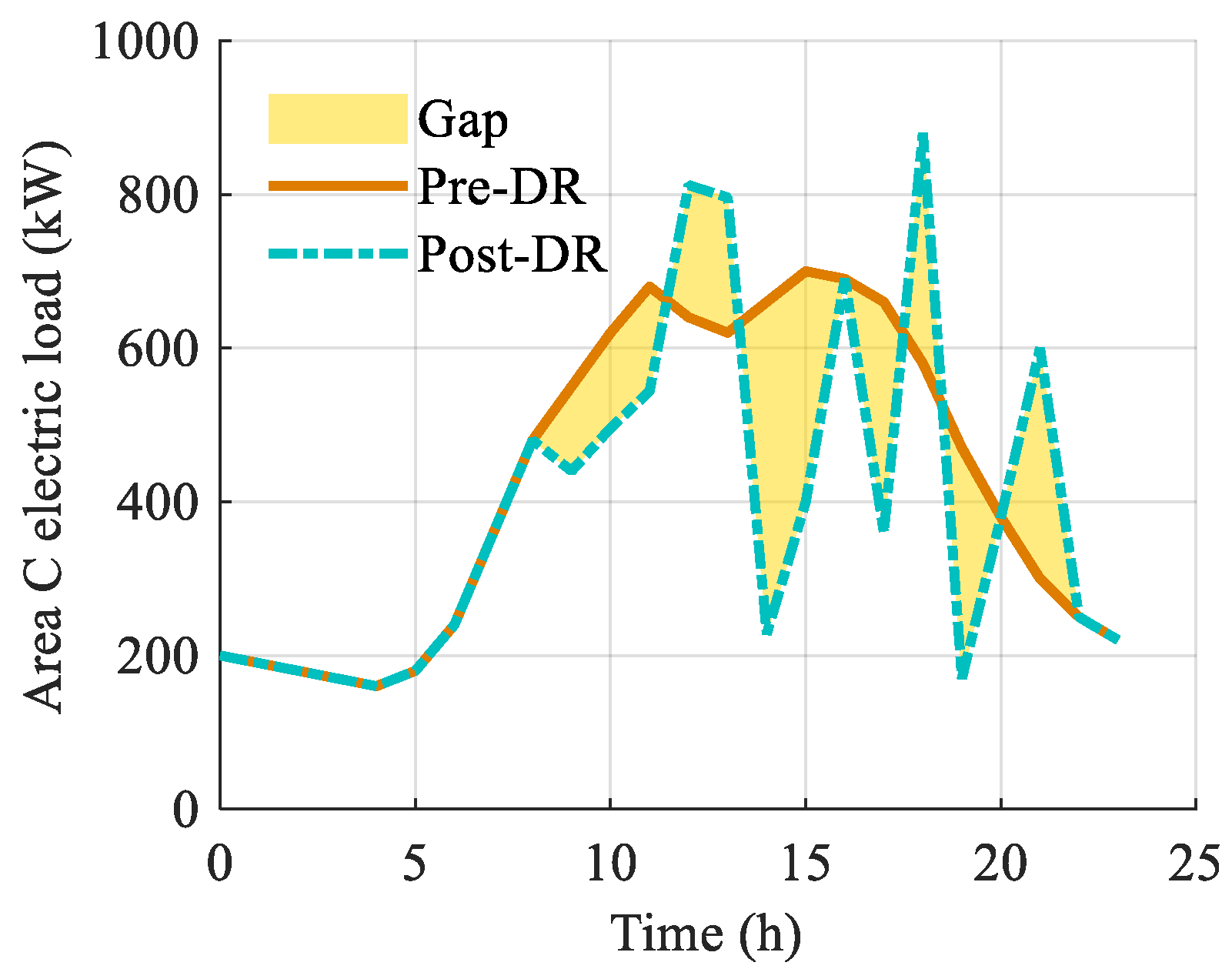


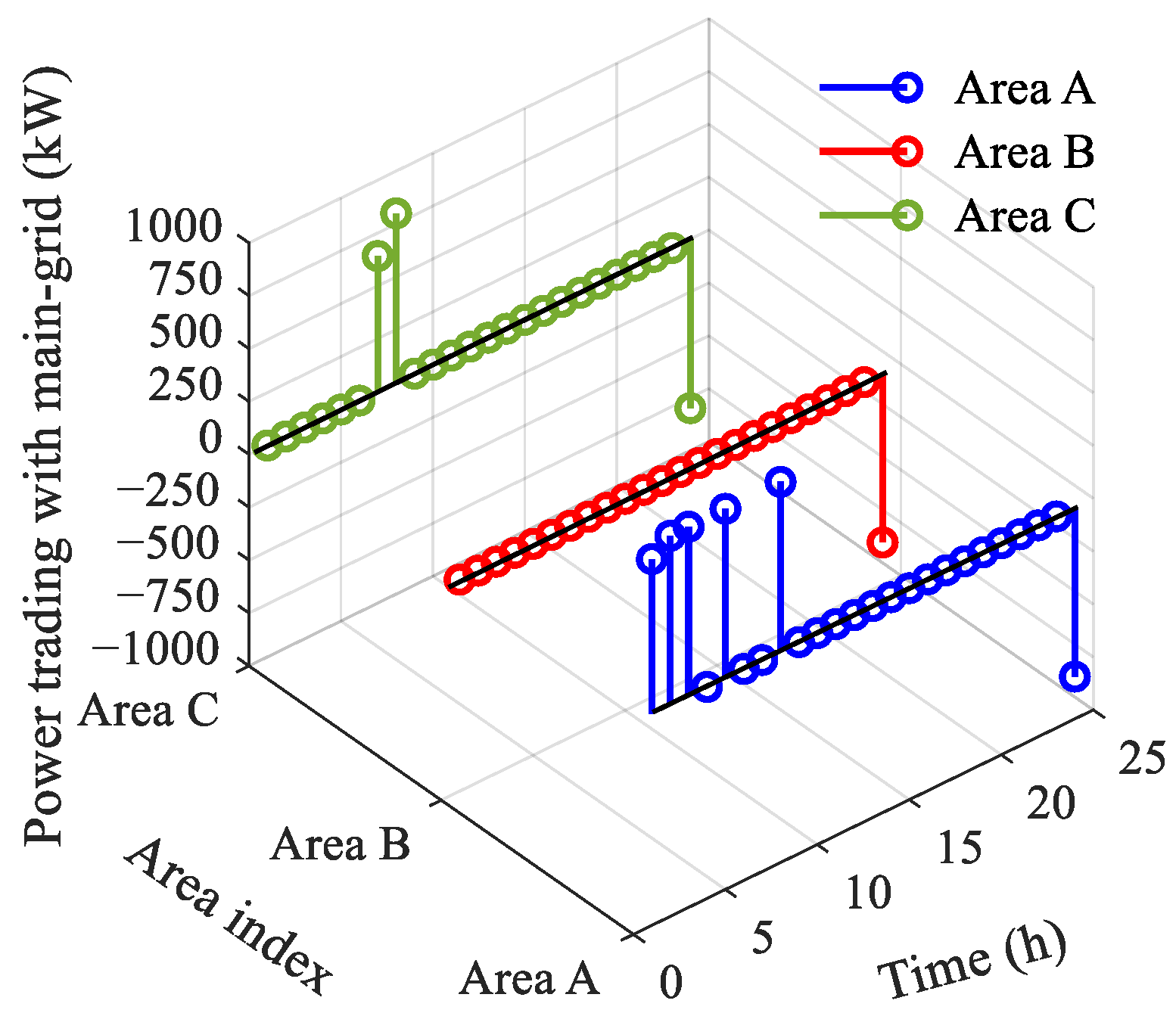
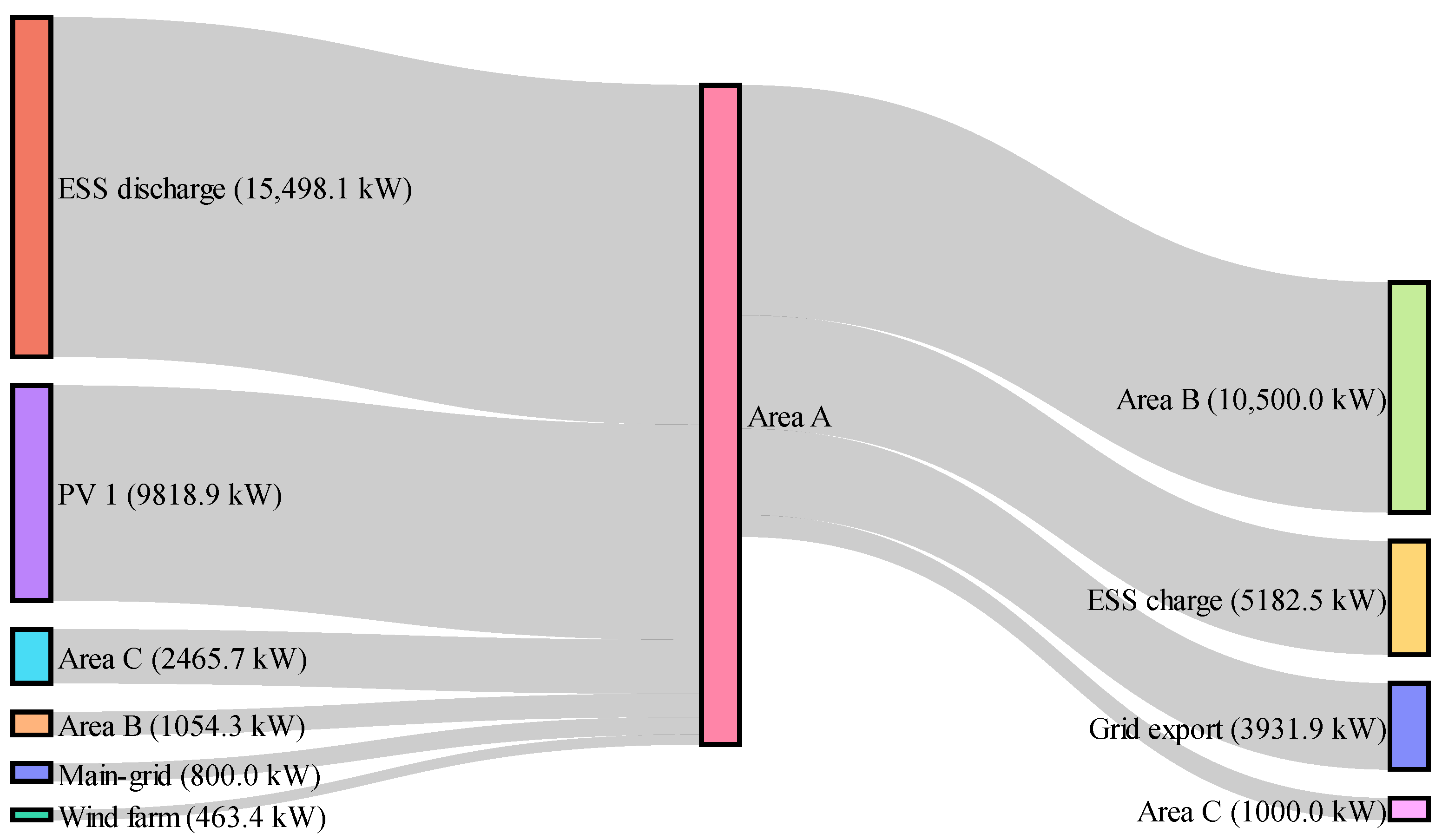
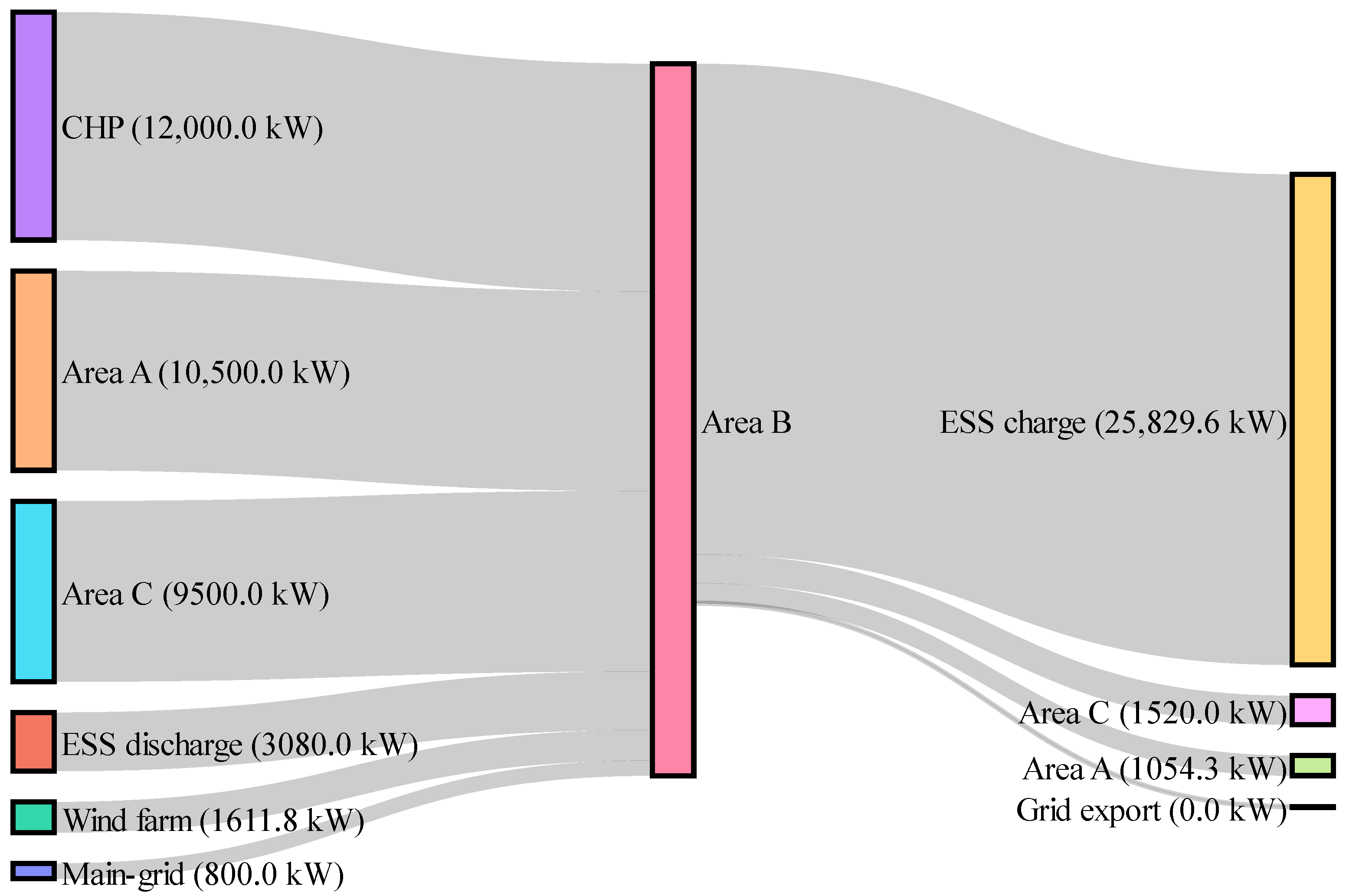

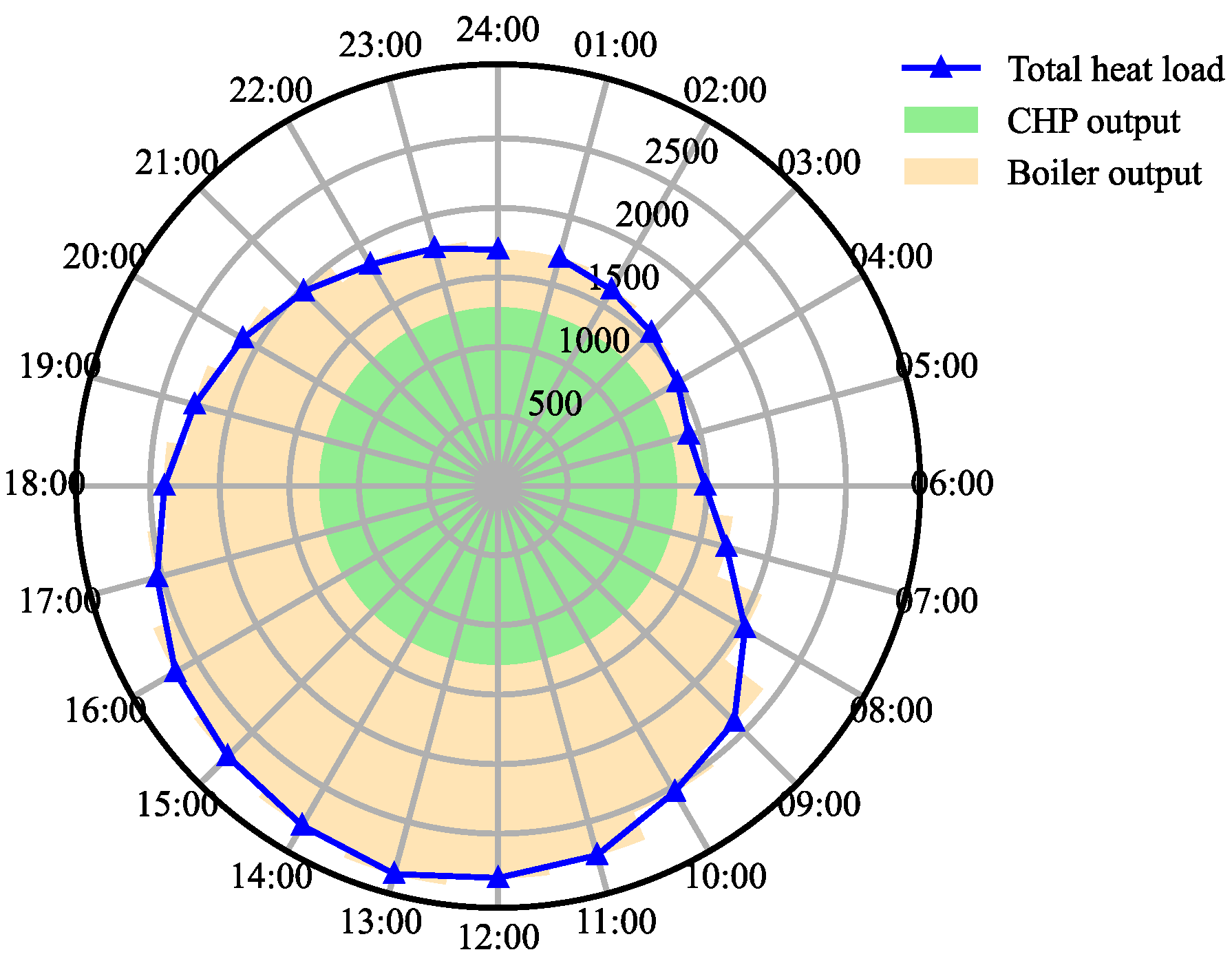
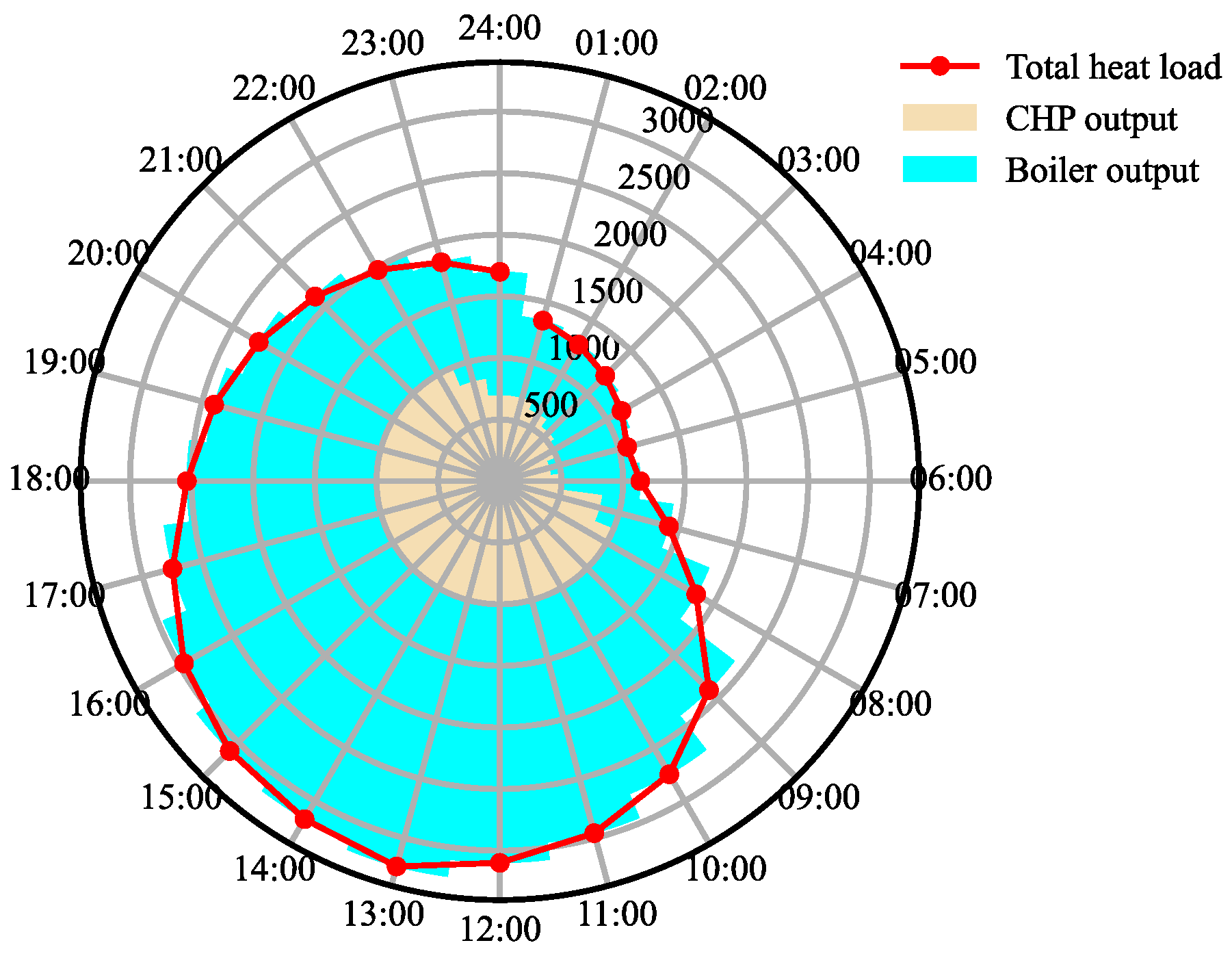

Disclaimer/Publisher’s Note: The statements, opinions and data contained in all publications are solely those of the individual author(s) and contributor(s) and not of MDPI and/or the editor(s). MDPI and/or the editor(s) disclaim responsibility for any injury to people or property resulting from any ideas, methods, instructions or products referred to in the content. |
© 2025 by the authors. Licensee MDPI, Basel, Switzerland. This article is an open access article distributed under the terms and conditions of the Creative Commons Attribution (CC BY) license (https://creativecommons.org/licenses/by/4.0/).
Share and Cite
Li, P.; Wang, L.; Zhang, P.; Yan, P.; Li, C.; Nan, Z.; Wang, J. Strategic Demand Response for Economic Dispatch in Wind-Integrated Multi-Area Energy Systems. Energies 2025, 18, 2188. https://doi.org/10.3390/en18092188
Li P, Wang L, Zhang P, Yan P, Li C, Nan Z, Wang J. Strategic Demand Response for Economic Dispatch in Wind-Integrated Multi-Area Energy Systems. Energies. 2025; 18(9):2188. https://doi.org/10.3390/en18092188
Chicago/Turabian StyleLi, Peng, Li Wang, Peiqiang Zhang, Peng Yan, Chongyang Li, Zhe Nan, and Jun Wang. 2025. "Strategic Demand Response for Economic Dispatch in Wind-Integrated Multi-Area Energy Systems" Energies 18, no. 9: 2188. https://doi.org/10.3390/en18092188
APA StyleLi, P., Wang, L., Zhang, P., Yan, P., Li, C., Nan, Z., & Wang, J. (2025). Strategic Demand Response for Economic Dispatch in Wind-Integrated Multi-Area Energy Systems. Energies, 18(9), 2188. https://doi.org/10.3390/en18092188




